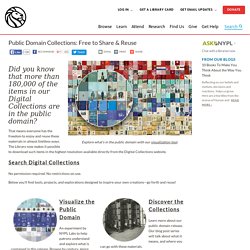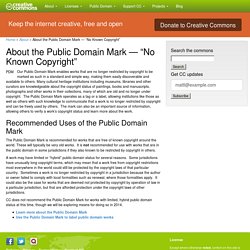

Welcome to The New York Public Library. Public Domain Collections: Free to Share & Reuse. That means everyone has the freedom to enjoy and reuse these materials in almost limitless ways.

The Library now makes it possible to download such items in the highest resolution available directly from the Digital Collections website. Search Digital Collections No permission required. No restrictions on use. Below you'll find tools, projects, and explorations designed to inspire your own creations—go forth and reuse! Visualize the Public Domain An experiment by NYPL Labs to help patrons understand and explore what is contained in this release. Discover the Collections Learn more about our public domain release. Apply for the Remix Residency To promote transformative, interesting, and creative new uses of our Digital Collections and data, NYPL is now accepting applications for a Remix Residency program. Use Our Data and Utilities Our digitized collections are available as machine-readable data: over one million records for you to search, crawl and compute.
Navigating the Green Books. Royalty free music. Public domain and copyright free classical music. Copyright Criminals - For Educators. About The Creative Commons Licenses. Our public copyright licenses incorporate a unique and innovative “three-layer” design. Each license begins as a traditional legal tool, in the kind of language and text formats that most lawyers know and love. We call this the Legal Code layer of each license. But since most creators, educators, and scientists are not in fact lawyers, we also make the licenses available in a format that normal people can read — the Commons Deed (also known as the “human readable” version of the license).
The Commons Deed is a handy reference for licensors and licensees, summarizing and expressing some of the most important terms and conditions. Think of the Commons Deed as a user-friendly interface to the Legal Code beneath, although the Deed itself is not a license, and its contents are not part of the Legal Code itself. Searching for open content is an important function enabled by our approach. About the Public Domain Mark — "No Known Copyright" - Creative Commons. Home » About » About the Public Domain Mark — “No Known Copyright” Our Public Domain Mark enables works that are no longer restricted by copyright to be marked as such in a standard and simple way, making them easily discoverable and available to others.

Many cultural heritage institutions including museums, libraries and other curators are knowledgeable about the copyright status of paintings, books and manuscripts, photographs and other works in their collections, many of which are old and no longer under copyright. The Public Domain Mark operates as a tag or a label, allowing institutions like those as well as others with such knowledge to communicate that a work is no longer restricted by copyright and can be freely used by others. The mark can also be an important source of information, allowing others to verify a work’s copyright status and learn more about the work. Download your Creative Commons Licence.
The following SVG, EPS, and PNG files should be used for print publications. Please see our policies page for more information about how our logos may be used. CC logos and trademarks should always be downloaded from this page to ensure high quality. Downloads from other sites may not conform to our standards and may result in improper display or use of our protected logos and trademarks. The SVG and EPS vector files are recommended for use in print materials — The standard screen resolution files will appear blurry or jagged if used in print. There are links to large format, high quality PNG versions of each graphic for web, print, presentations, and video. Logos Logo set in Akzidenz Grotesk Bold. Buttons Icons Stickers Six licenses for sharing your work—Simple, quick introduction to Creative Commons licenses.
Guide to using public domain tools—Simple, quick introduction to Creative Commons’ public domain tools. Three Layers of License (png). What is Creative Commons? Videos Colors. Wikimedia Commons. Wikimedia. Lesson plan - Copyrights: whose rights?
I'm sharing here a lesson-plan on copyrights I've created with friend & eTwinner Paola Arduini during the eTwinning Ambassador course 2012.

Since at school I'm at the moment addressing this kind of topics, and in the web-age we're all involved in sharing vs protecting ownership, I think it can be useful to others as well.Title of the lesson:Copyrights: whose rights? Age range of pupils targeted by this lesson plan: students 10-12 years old (last year of Primary School, first year of Secondary School) Description:- First steps in the world of Copyrights. The students at this age are usually already familiar with the web. They can work on their own assignments/homework, both alone or in a team, using ICT tools.
This lesson, that can also suit the beginning of any eTwinning or international project (the “introductions” part) can trigger a discussion and reflection on the use of web materials and the importance of copyrights. We can start from here, following these steps: 9. 10. 11.